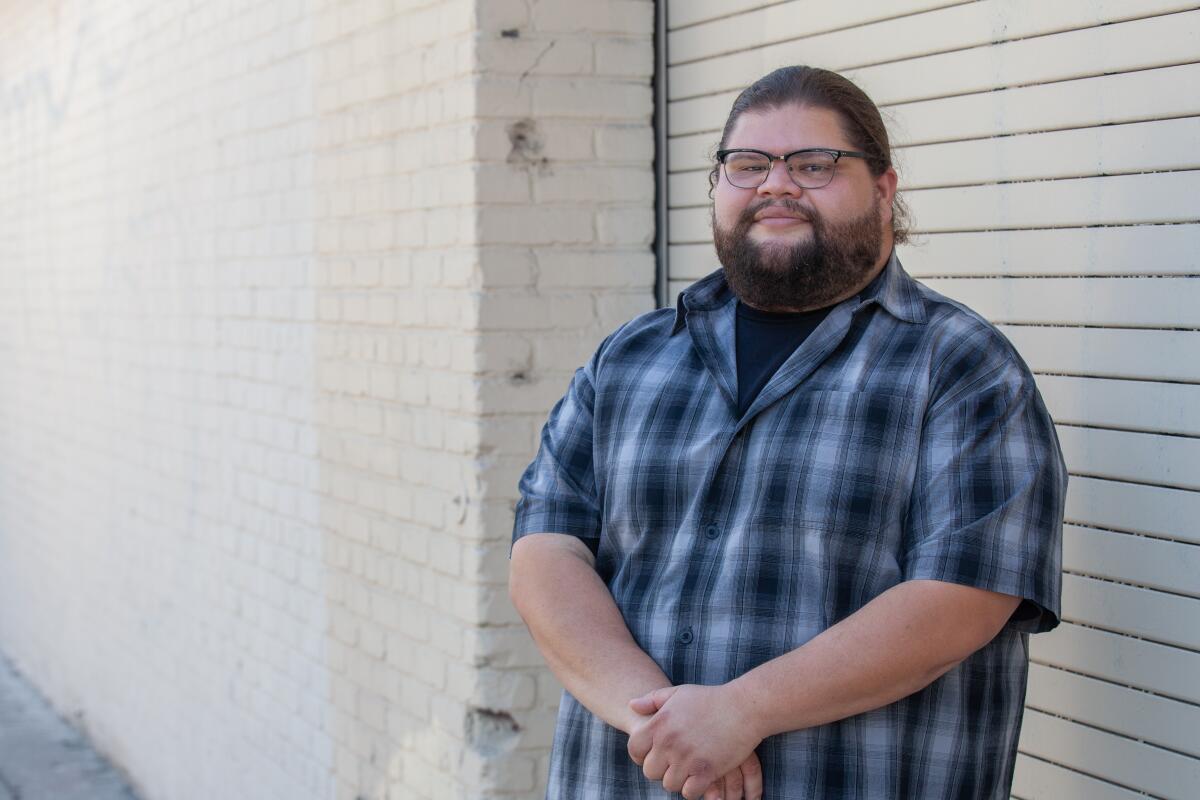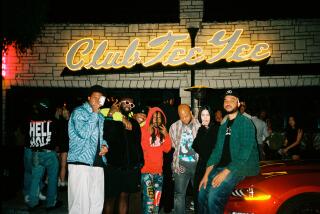Google Street View galvanized this artist to create an emotive blueprint of South L.A.

One afternoon in 2012, a man drove down a residential street in southeast Los Angeles. Unbeknownst to him, at that exact moment, a Google Street View camera nearby snapped a photo of him. Years later, multidisciplinary artist and educator Felix Quintana saw this image and recognized the person in the photograph: his father.
With Google Maps Street View, the focus on buildings and roads diminishes figures. By obscuring the faces caught between moments, people almost appear invisible. In his practice, Quintana manipulates these Google images using cyanotypes, an early photographic technique that produces prints coated with a Prussian shade. With collage-making, he plays around with different textures â some are created with a stucco finish, others smoother. The found materials and assemblage pieces reference signs and landmarks unique to Quintana.
Quintana, who works with the mediums of photography, poetry, drawings and sculpture, often asks a compelling question in his work: âHow can we visualize the past in the contemporary moment?â Shifting perspectives and reframing narratives are themes Quintana also revisits in a recently opened solo show, âLove is the Given of the Place,â at Edouard de Merlier Photo Gallery, Cypress College, and a group exhibition, âWe Run Things, Things Donât Run We,â by Slanguage Studio.
The 31-year-old artist grew up in Lynwood, where his parents sought refuge from El Salvadorâs civil war. He grew up just three miles from the Watts Towers, and yet there was a spatial distance between him and the sculptural monument. âI feel like thatâs a metaphor for how close yet so far I was to world-class art,â he says. âIt took my exploration through public transit or by car to be able to witness something so profound like the towers.â
As a kid, Quintana accompanied his mother to Encino, where she worked as a childrenâs caretaker. He vividly remembers being inspired by a Frank Romero mural, âGoing to the 1984 Olympics.â Along the walls of the Hollywood Freeway, the imagery of pastel-colored automobiles, heart shapes and palm trees slowly fading from the blistering sun stood out.
Formative years included bus rides to Fairfax Avenue, a destination for skateboarders and hip-hop heads. Quintana, just a teenager, was introduced to photography, where he chronicled street happenings, backyard shows and graffiti. His parents, who gave him a Nikon camera for a high school photography class, supported his endeavors.
Review: Slanguage marks anniversary in âMade in L.A.â at LAXART
While studying studio art and photography at Cal Poly Humboldt, he experimented with self-portraits. âI was doing a lot of interior work,â he says. âIt was rare to photograph brown male bodies.â Quintana recorded himself performing free-flowing dance movements â stacking long-exposure photos of light to create a mark. He found that each image revealed further proportion and depth. âThe camera was like a paintbrush or pen,â he says. âIt was very abstract.â
After graduating, Quintana worked as a teaching artist, adopting models of social practice introduced by artists and educators Mario Ybarra Jr. and Karla Diaz of Slanguage Studio, an artist-run space in Wilmington. He later obtained a master of fine arts in photography at San Jose State University.
There, Quintana found that cyanotypes â once used for architectural designs â could serve as an emotional and cultural blueprint of L.A. This art form would allow him to engage with subjects, bringing people, objects and locales into focus while adding context to signage and exteriors like walls, gates and sidewalks, which Street View often neglects. The manual approach of cyanotypes, countering the rapidness of Google technology and digital characteristics, offered Quintana time to thoughtfully develop the image.
Quintana credits James Rojas, community activist and urban planner whose concept of âLatino urbanismâ examines how traditions are part of the cultural landscape as a key influence. âIf you go to East Los Angeles,â Quintana shares, âyou will notice the houses donât start at the front door; they begin at the yard.â
Quintana knows the history of photography but enters the medium in a new way, says Vanessa Arizmendi, a curatorial associate at the Hammer Museum.
His process is multifaceted: Quintana takes screenshots of Google images, creating digital negatives that undergo heavy editing. Then, he hand-coats a paper with a cyanotype solution that adds slickness to the piece. Once dry, he presses a piece of glass against the materials, which results in a contact print. Quintana then scratches onto the surface with a blade, leaving white sketches of bushes, for example, sprouting from asphalt, that captures elements of erasure and existence. In the final stages, the photo is exposed to ultraviolet light and developed in liquids.
âThe images that he works with, even just the etchings, palm trees and mimicking of grilles on a metal screen door, is so much about a particular kind of language that some of us are familiar with,â Arizmendi says. This familiarity she describes is palpable among those close to the subject matter, almost like the inscriptions are a part of collective memory.
His most circulated series, the âLos Angeles Blueprintsâ (2019-present), is a response to the work of Doug Rickard, a white artist and photographer from San Jose who amassed a collection of Street View images, archiving primarily communities of color along the Rust Belt. For Quintana, sourcing photos of places under surveillance opens up conversations about intervention and offers reverence to pedestrians, street vendors and laborers.
In his piece âFamilies Walking to Paramount Swapmeetâ (2022), rituals in public spaces become sacred. Some of the titles stem from Quintanaâs own observations, such as âPosted on an Inglewood Corner, City of Changesâ (2022) or âCholo Walking by the Pawn Shop at a Strip Mall in Comptonâ (2022).
He adds another dimension with collages in âPara los Lil Homiesâ (2019-present), some of which are in his solo exhibition. âMuch of my work is a dialogue in response to literary material,â he says. The chosen title, âLove is the Given of the Place,â borrowed from Roberto Lovatoâs memoir, repurposes Joan Didionâs reference to El Salvador: âTerror is the given of the place.â
âEven though there is struggle happening in these neighborhoods, there is beauty,â Quintana says. The show is a tribute to the Salvadoran diaspora, featuring blueprints, mixed-media collages and installations. He adds, âIt is also dedicated to L.A. and the places that have strongly impacted and influenced me.â
Quintana is also showing with Slanguage Studio as part of its 20th anniversary group exhibition. Inside Angels Gate Cultural Center in San Pedro, Quintana focuses on site-specific work with framed postcard cyanotypes that map a conceptual route in Wilmington. Outside, Quintana transforms the images into a digital collage banner offering a panoramic view. It serves as an âinsider tourâ featuring familiar sites, like the Don Hotel or Fallas Paredes store. Quintana also chose an image of a historical Chicano mural painted on a former liquor store that local artists restored, and the building Slanguage Studio now sits in when it was an auto shop.
âI wanted to mainly honor Wilmington and those spots that youâd only know if you grew up there, or, in my case, had a lot of friends and mentors from there who would show me these places,â he says.
Quintana has long been thinking about how we consume images, not just how we make them, and what tools youth are equipped with when interacting with portrayals of themselves. Thatâs part of what drives him to teach digital photography at Cerritos College and arts education at UCLA. âAbove all else, I lean on breaking ceilings for the next generation who follows me,â he says.
More to Read
The biggest entertainment stories
Get our big stories about Hollywood, film, television, music, arts, culture and more right in your inbox as soon as they publish.
You may occasionally receive promotional content from the Los Angeles Times.










